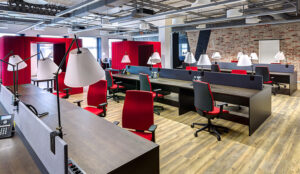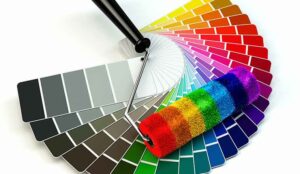Your choice in call centre furniture can have a huge effect on both your staff and their productivity. Here, Heather Wright talks through the things you should bear in mind in order to make the right decisions.
Musculoskeletal disorders such as low back pain, joint injuries and repetitive strain injuries are the most common occupational illness in Great Britain. They affect an estimated 1billion people a year and cost society 5.7billion annually. Choosing the right furniture for your call centre is therefore a vital component in business continuity.
The impact that call centre furniture has on an individual will depend upon the consideration given to the task they must perform at the workstation. Performance will be impacted upon if staff are given inadequate space to perform their tasks or if their comfort is not given sufficiently high priority when chairs and workstations are selected.
Failure to take in to account the needs of the employee when planning accommodation and furniture will lead to dissatisfied staff and may ultimately impact on the health of the workforce, their productivity, organisational sickness levels and retention rates. But just how do you go about selecting the best type of furniture for your organisation?
Over the past 12 years or so, office furniture manufacturers and retailers have recognised the changing face of the call centre environment and have designed and manufactured a wide range of desks that reflect this. However, furniture companies do not have to live with the consequences of the furniture they provide and therefore the following points should be considered when designing the environment.
1) Organisational culture and drivers
Does your organisation value your employees and customers? The most obvious answer should be yes to both. However, the design of many of the earlier call centres led to negative press about ‘battery hen conditions’ where staff were given inadequate work space – often in straight rows – in an attempt to create best value per square foot on accommodation costs. It was a ‘squash them up and pile them high’ approach.
While all organisations need to have cost effective accommodation, this should not be to the detriment of the working conditions, morale and productivity of the staff. Therefore be realistic about the space you have available and don’t create too dense a floor plate. The legal minimum space a person should have is around 40 square foot per person. Having said that, 60 to 80 square foot creates a far more comfortable environment.
2) Tasks of the workforce
Consider carefully the tasks that the staff will be doing at their desks. While call centres are predominantly planned to be paper free environments, they very often aren’t. This is a critical consideration when choosing your furniture. If you can be absolutely confident that your staff will never need anything more than their PCs, keyboard and a headset, then smaller desks are fine. If they are likely to need to have access to files and paper, then do not install very small desks as you will effectively be forcing them to work in a cluttered environment and often adopting poor posture, which can lead to muscle strain and injury.
Consideration must also be given to where PC base units are to be stored. While flat screen technology supports the use of smaller desks, it is no good to then put the base unit on top of a small desk. Frames that hang from the underside of desks are a good idea for clearing clutter from the desk surface and floor.
3) Team spirit and the workforce morale
Consider how your organisation works and how teams are structured. If teams work closely together and need frequent interaction, you may want to create banks of desks to reflect the size of your teams. This can be done, for example, with circular desk configurations or in ‘snake-like’ clusters according to the size of your team. Avoid putting your teams together in straight rows as this creates the look and feel of a work-house or production line and is a very old-fashioned approach.
4) Desk styles
There are a number of frequently used desk types in call centres. These include left- or right-handed wave desks, where one end of the desk is deeper than the other to allow space for PCs and keyboards; 120 degree workstations, which tend to be smaller desks and are a V-shape with the depth in the centre; left- or right-handed workstations where a straight desk has a return on one side; and numerous other shapes intended to reflect the working environment of the call centre. The type of desk you choose should again reflect the tasks to be carried out by the staff, but do remember that small desks will restrict movement and could lead to your staff feeling hemmed in and undervalued.
5) Desk dividers
Fabric covered dividers between desks help to deaden noise and create some privacy for the staff. They are also aesthetically pleasing and carry through your colour schemes. There are a variety of heights to choose from and, again, consideration needs to be given to the level of interaction staff need to have with their peers. Don’t use dividers as a means to stop interaction, though, as this will lead to poor morale.
6) Chairs
It is absolutely essential that good quality chairs are chosen for your staff. They must be height adjustable with adjustable back positioning. Armrests are a personal choice but if they are provided, they too must be adjustable. Chairs don’t generally come with anything above a five-year guarantee – against ten years for most good quality desks – because they take such heavy use. Buying cheap chairs will very often end up more expensive in the long run as they may have to be replaced more frequently and again can lead to poor posture and muscle strain.
7) Team leaders/managers
It is probable that team leaders and managers will have more paper-based activity than their team members. Ensure that they are given sufficient space for their papers and files. They will probably also need more privacy in order to speak to their staff on an individual basis. Ensure this is factored in to your planning and give them bigger desks if necessary.
8) Peripheral furniture
Establish what other furniture your staff will need. For example, if hot-desking is used in your organisation, you may wish to provide your staff with mobile pedestals in order for them to take their personal possessions and necessary files from desk to desk with ease. Factor filing cabinets in to your space planning, and areas for printers, fax machines, photocopiers and so on.
9) Break-out areas
Legally staff must be given the opportunity to take breaks away from their desks during the working day. Break-out areas create an opportunity for interaction and are a good location to provide drinking and eating facilities. High fabric or similar screens around the break-out area mean staff can have a break without having to look at the work environment. This will help them relax more effectively.
10) Disability discrimination
As is required by law, all organisations must take in to account the Disability Discrimination Act in their general design and in the furniture provided. Height adjustable desks are widely available, as are a very wide variety of adjustable chairs. Ensure you support any member of staff who may have special needs for their furniture and environment.
11) Training
Ensure your staff are trained in the use of their furniture and be sure they understand how they should sit and how their chairs should be adjusted for their use. This will cut down considerably on strain injuries and incidences of sickness. Consider purchasing a CD-Rom training package that staff can watch at their own desks or view as part of the induction process.
12) General space planning
When selecting a location for your call centre, try to remember the following points:
- The best floor plate for call centre environments is large, open plan space. Narrow floor plates make the space less flexible and lead to a less cost-effective environment.
- Make sure that the air conditioning is designed to meet the needs of your environment. If the air conditioning has been designed to cope with a floor density of 120 square feet per person, as is the case in general office use, it will be unlikely to be suitable if you are working to a 40 square foot per person floor plate.
- Make maximum use of natural light. All staff like to have the opportunity to see the outside world. Do not place all managers’ offices, meeting rooms and training rooms around the outside walls, thus cutting off natural light to the call centre staff.
- Remember to factor in sufficient meeting rooms. Staff need to have privacy for performance reviews and private conversations with their managers.
- Colour schemes are important. If possible, give the staff an opportunity to create their own environment and choose their own colours. Corporate design may look great on the letterheads, but might not roll out so well on carpets, walls and fabrics.
- Staff like to control their environment. If possible, give your staff the opportunity to select their own heating and lighting levels.
- Remember the impact of the environment on staff. Break up your floor space, use pictures on the walls to soften the atmosphere, install plants, deaden the general noise levels by using fabric covered screens, good quality carpets and fabric break-out furniture. Avoid having your desks in straight rows. Use relaxing colour schemes in break-out areas and appropriate colour schemes in the rest of the building and give the staff sufficient break-out areas where they can relax and have something to eat and drink.
Stand your ground for your staff. Don’t let an organisation push you into high density floor space planning as the staff will not be happy or productive and will leave to work for more progressive-thinking companies. This ultimately costs the company more money on recruitment and training and attracts a poor public reputation that is often difficult to shake off.
However, be realistic about the organisational goals. It is a difficult balance, but it is possible for everyone to be happy.
Heather Wright is a facilities management consultant and owns the consultancy 1FM
Tel: +44 1625 532023
Website: www.onefm.co.uk
The following comments have been posted relating to this article:
Great article…. have you any more articles on call centre ergonomics— especially desk type–seat type— colour schemes? (posted by Kieran)
Call centre ergonomics I’m afraid that we have not got anything more on the site about ergnomics, but it is a good idea and we will see if we can add this on to the editorial calendar. Does anyone else have any experience in this area? (posted by Jonty Pearce)
Author: Jonty Pearce
Published On: 24th Feb 2006 - Last modified: 15th Aug 2025
Read more about - Customer Service Strategy, Environment, Service Strategy





































